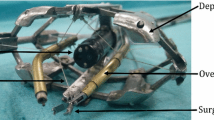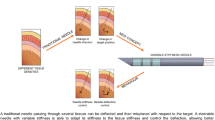Abstract
Magnetic resonance (MR) compatible needle manipulators can assist physicians with the insertion of biopsy needles and needle-like therapeutic instruments directly into millimeter-size tumors, using MR images as feedback. However, magnetic resonance imaging (MRI) systems present a challenging operational environment with high magnetic fields and limited space, making the development of MR-compatible robots difficult. In this paper, we present design requirement analysis and a novel prototype design for an MRIguided biopsy needle manipulator and an MR-compatible transmission that provides sufficient driving forces for needle manipulation inside an MR scanner. The actuators of the manipulator are placed outside the MR room, which are several meters away from the scanner. A combination of a pull-pull cable-sheath and a cable-pulley transmission is used to transmit the actuator force to the manipulator. This configuration can be used to achieve MR-compatibility and leads to the ability to use conventional actuators such as DC motors, which have sufficiently high power to perform needle biopsy. We also studied the feasibility of the proposed transmission and actuation with the proposed manipulator. The accuracy and precision of the needle tip are evaluated and MRcompatibility is verified.
Similar content being viewed by others
Abbreviations
- θ 1 :
-
rolling angle of the manipulator
- θ 2 :
-
pitching angle of the manipulator
- d :
-
sliding displacement of the manipulator
- sθ i :
-
sin θ i
- cθ i :
-
cos θ i
- J i :
-
ith joint axis (J 1: roll, J 2: pitch, J 3: slide)
- x, y, z:
-
x, y and z-directional position of the needle tip with respect to base coordinate system, respectively
References
Kim, Y. H. and Le Minh, H., “A Laboratory-Level Surgical Robot System for Minimal Invasive Surgery (MIS) Total Knee Arthroplasty,” Int. J. Precis. Eng. Manuf., Vol. 12, No. 2, pp. 237–242, 2011.
Na, Y., Seo, J.-M., and Kim, J., “Electromagnetic Tracking of Needle Intervention for Sacral Nerve Stimulation using the Image-Guided Surgery Toolkit (IGSTK),” Int. J. Precis. Eng. Manuf., Vol. 14, No. 11, pp. 2015–2020, 2013.
Elhawary, H., Tse, Z. T. H., Hamed, A., Rea, M., Davies, B. L., and Lamperth, M. U., “The Case for MRCompatible Robotics: A Review of the State of the Art,” The International Journal of Medical Robotics and Computer Assisted Surgery, Vol. 4, No. 2, pp. 105–113, 2008.
Gassert, R., Burdet, E., and Chinzei, K., “Opportunities and Challenges in MR-Compatible Robotics,” IEEE Engineering in Medicine and Biology Magazine, Vol. 27, No. 3, pp. 15–22, 2008.
Gassert, R., Yamamoto, A., Chapuis, D., Dovat, L., Bleuler, H., and Burdet, E., “Actuation Methods for Applications in MREnvironments,” Concepts in Magnetic Resonance Part B: Magnetic Resonance Engineering, Vol. 29, No. 4, pp. 191–209, 2006.
Gassert, R., Moser, R., Burdet, E., and Bleuler, H., “MRI/fMRICompatible Robotic System with Force Feedback for Interaction with Human Motion,” IEEE Asme Transactions on Mechatronics, Vol. 11, No. 2, pp. 216–224, 2006.
Masamune, K., Kobayashi, E., Masutani, Y., Suzuki, M., Dohi, T., et al., “Development of an MRI-Compatible Needle Insertion Manipulator for Stereotactic Neurosurgery,” Journal of Image Guided Surgery, Vol. 1, No. 4, pp. 242–248, 1995.
Suzumori, K., Hashimoto, T., Uzuka, K., and Enomoto, I., “Pneumatic Direct-Drive Stepping Motor for Robots,” Proc. of IEEE/RSJ International Conference on Intelligent Robots and Systems, pp. 2031–2036, 2002.
Stoianovici, D., Patriciu, A., Petrisor, D., Mazilu, D., and Kavoussi, L., “A New Type of Motor: Pneumatic Step Motor,” IEEE/ASME Transactions on Mechatronics, Vol. 12, No. 1, pp. 98–106, 2007.
Stoianovici, D., Kim, C., Srimathveeravalli, G., Sebrecht, P., Petrisor, D., et al., “MRI-Safe Robot for Endorectal Prostate Biopsy,” IEEE/ASME Transactions on Mechatronics, Vol. 19, No. 4, pp. 1289–1299, 2014.
Chapuis, D., Gassert, R., Ganesh, G., Burdet, E., and Bleuler, H., “Investigation of a Cable Transmission for the Actuation of MRCompatible Haptic Interfaces,” Proc. of the 1st IEEE/RAS-EMBS International Conference on Biomedical Robotics and Biomechatronics, pp. 426–431, 2006.
Menon, S., Brantner, G., Aholt, C., Kay, K., and Khatib, O., “Haptic FMRI: Combining Functional Neuroimaging with Haptics for Studying the Brain's Motor Control Representation,” Proc. of 35th Annual International Conference of the IEEE Engineering in Medicine and Biology Society (EMBC), pp. 4137–4142, 2013.
Vigaru, B., Sulzer, J., and Gassert, R., “Design and Evaluation of a Cable-Driven fMRI-Compatible Haptic Interface to Investigate Precision Grip Control,” IEEE Transactions on Haptics, Vol. 9, No. 1, pp. 20–32, 2016.
General Electric Company, “Optima MR450w, Optima 450w GEM, Preinstallation Manual,” http://docplayer.net/13181709-Optimamr450w-preinstallation-manual.html (Accessed 22 JUL 2016)
Silva, M., “Microfocus X-ray Sources,” http://www.bibliocad.com/library/mri-room-2_56385 (Accessed 5 JUL 2016)
Wu, Q., Wang, X., Chen, L., and Du, F., “Transmission Model and Compensation Control of Double-Tendon-Sheath Actuation System,” IEEE Transactions on Industrial Electronics, Vol. 62, No. 3, pp. 1599–1609, 2015.
DiMaio, S. P., Pieper, S., Chinzei, K., Hata, N., Haker, S., et al., “Robot-Assisted Needle Placement in Open MRI: System Architecture, Integration and Validation,” Computer Aided Surgery, Vol. 12, No. 1, pp. 15–24, 2007.
Krieger, A., Song, S.-E., Cho, N. B., Iordachita, I. I., Guion, P., et al., “Development and Evaluation of an Actuated MRI-Compatible Robotic System for MRI-Guided Prostate Intervention,” IEEE/ASME Transactions on Mechatronics, Vol. 18, No. 1, pp. 273–284, 2013.
Wallner, K., Blasko, J., and Dattoli, M. J., “Prostate Brachytherapy: Made Complicated,” SmartMedicine Press, 2nd Ed., 2001.
Bak, J. B., Landas, S. K., and Haas, G. P., “Characterization of Prostate Cancer Missed by Sextant Biopsy,” Clinical Prostate Cancer, Vol. 2, No. 2, pp. 115–118, 2003.
Krieger, A., Iordachita, I. I., Guion, P., Singh, A. K., Kaushal, A., et al., “An MRI-Compatible Robotic System with Hybrid Tracking for MRI-Guided Prostate Intervention,” IEEE Transactions on Biomedical Engineering, Vol. 58, No. 11, pp. 3049–3060, 2011.
Schenck, J. F., “The Role of Magnetic Susceptibility in Magnetic Resonance Imaging: MRI Magnetic Compatibility of the First and Second Kinds,” Medical Physics, Vol. 23, No. 6, pp. 815–850, 1996.
Victrex, “Victrex Peek Polymers,” https://www.victrex.com/ko/products/victrex-peek-polymers (Accessed 5 JUL 2016)
Plasticsintl, “TIVAR 1000, Ultra High Molecular Weight Polyethylene, UHMW-PE,” https://www.plasticsintl.com/datasheets/UHMW_PE.pdf (Accessed 5 JUL 2016)
Stoianovici, D., “Multi-Imager Compatible Actuation Principles in Surgical Robotics,” The International Journal of Medical Robotics and Computer Assisted Surgery, Vol. 1, No. 2, pp. 86–100, 2005.
Yu, N., Gassert, R., and Riener, R., “Mutual Interferences and Design Principles for Mechatronic Devices in Magnetic Resonance Imaging,” International Journal of Computer Assisted Radiology and Surgery, Vol. 6, No. 4, pp. 473–488, 2011.
Hsia, T. C. and Gao, L. S., “Robot Manipulator Control using Decentralized Linear Time-Invariant Time-Delayed Joint Controllers,” Proc. of IEEE International Conference on Robotics and Automation, Vol. 3, pp. 2070–2075, 1990.
National Electrical Manufactures Association, “Determination of Signal-to-Noise Ratio (SNR) in Diagnostic Magnetic Resonance Imaging,” Document ID: 100123, 2008.
Firbank, M. J., Coulthard, A., Harrison, R. M., and Williams, E., “A Comparison of Two Methods For Measuring the Signal to Noise Ratio on MRImages,” Physics in Medicine and Biology, Vol. 44, No. 12, pp. N261–N264, 1999.
Author information
Authors and Affiliations
Corresponding author
Rights and permissions
About this article
Cite this article
Kim, ST., Kim, Y. & Kim, J. Design of an MR-compatible biopsy needle manipulator using pull-pull cable transmission. Int. J. Precis. Eng. Manuf. 17, 1129–1137 (2016). https://doi.org/10.1007/s12541-016-0137-2
Received:
Revised:
Accepted:
Published:
Issue Date:
DOI: https://doi.org/10.1007/s12541-016-0137-2




